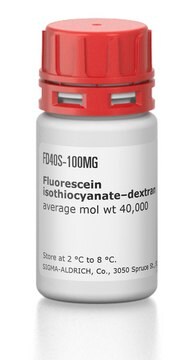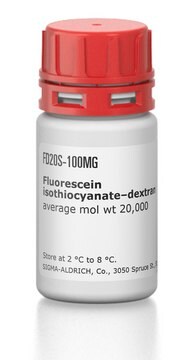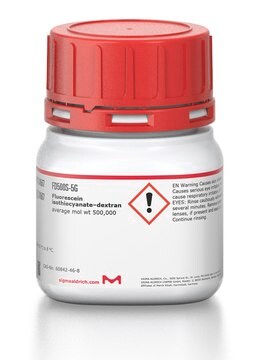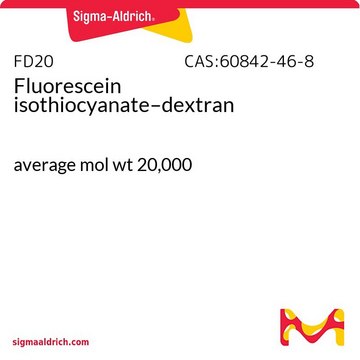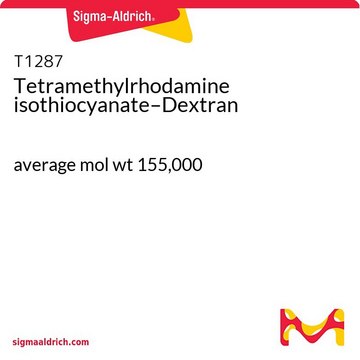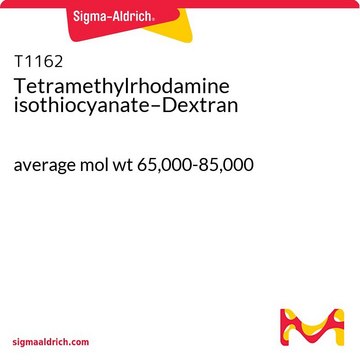FD2000S
Fluorescein isothiocyanate–dextran
average mol wt 2,000,000
Synonym(s):
FITC–Dextran
Sign Into View Organizational & Contract Pricing
All Photos(4)
About This Item
Recommended Products
biological source
synthetic (organic)
Quality Level
conjugate
FITC conjugate
form
powder
mol wt
average mol wt 2,000,000
extent of labeling
0.003-0.020 mol FITC per mol glucose
color
yellow to orange
solubility
H2O: soluble 25 mg/mL
storage temp.
2-8°C
Looking for similar products? Visit Product Comparison Guide
General description
Dextran is a polymer of anhydroglucose. It is composed of approximately 95% alpha-D-(166) linkages. The remaining (163) linkages account for the branching of dextran. Conflicting data on the branch lengths implies that the average branch length is less than three glucose units. However, other methods indicate branches of greater than 50 glucose units exist. Native dextran has been found to have a molecular weight (MW) in the range of 9 million to 500 million. Lower MW dextrans will exhibit slightly less branching and have a more narrow range of MW distribution. Dextrans with MW greater than 10,000 behave as if they are highly branched. As the MW increases, dextran molecules attain greater symmetry. Dextrans with MW of 2,000 to 10,000, exhibit the properties of an expandable coil. At MW below 2,000, dextran is more rod-like. The MW of dextran is measured by one or more of the following methods: low angle laser light scattering, size exclusion chromatography, copper-complexation and anthrone reagent colorometric reducing-end sugar determination and viscosity.
Application
Dextran labeled with fluorescein isothiocyanate for possible use in perfusion studies in animals.
FITC-dextran is used extensively in microcirculation and cell permeability research utilizing microfluorimetry. FITC-dextran has been used to study plant cell wall porosity and capillary permeability. Plasma proteins have been shown not to bind to FITC-dextran.
Fluorescein-dextran, 2000 kDa, was used for in vivo imaging of brain microvasculature in active mice using a minature integrated fluorecent microscope. FITC-dextran, 2000 kDa (FD-2000) is used in cardiovascular, microcirculation, perfusion and cell membrane permeability research as fluorescent flux tracer compound that supports the measurement of processes such as blood flow, membrane damage, vascular drainage and renal elimination. Fluorescein-dextran, 2000 kDa, may be used for in vivo imaging of brain microvasculature in active mice using a miniature integrated fluorescent microscope. FITC-dextran has been used to study plant cell wall porosity.
Preparation Note
Sigma typically tests the solubility of FITC dextrans in water at concentrations at or above 25 mg/ml. Solutions should be protected from light. In vivo, FITC-dextran is stable for more than 24 hours.
Other Notes
To gain a comprehensive understanding of our extensive range of Dextrans for your research, we encourage you to visit our Carbohydrates Category page.
Signal Word
Warning
Hazard Statements
Precautionary Statements
Hazard Classifications
Eye Irrit. 2 - Skin Irrit. 2 - STOT SE 3
Target Organs
Respiratory system
Storage Class Code
11 - Combustible Solids
WGK
WGK 3
Flash Point(F)
Not applicable
Flash Point(C)
Not applicable
Personal Protective Equipment
dust mask type N95 (US), Eyeshields, Gloves
Choose from one of the most recent versions:
Already Own This Product?
Find documentation for the products that you have recently purchased in the Document Library.
Customers Also Viewed
Philipp M Summers et al.
Journal of cerebral blood flow and metabolism : official journal of the International Society of Cerebral Blood Flow and Metabolism, 37(11), 3599-3614 (2017-01-17)
Clinical studies have revealed a strong link between increased burden of cerebral microinfarcts and risk for cognitive impairment. Since the sum of tissue damage incurred by microinfarcts is a miniscule percentage of total brain volume, we hypothesized that microinfarcts disrupt
Kunal K Ghosh et al.
Nature methods, 8(10), 871-878 (2011-09-13)
The light microscope is traditionally an instrument of substantial size and expense. Its miniaturized integration would enable many new applications based on mass-producible, tiny microscopes. Key prospective usages include brain imaging in behaving animals for relating cellular dynamics to animal
Poornima Venkat et al.
Neurobiology of aging, 50, 96-106 (2016-12-13)
We investigated cognitive function, axonal/white matter (WM) changes and glymphatic function of vascular dementia using a multiple microinfarction (MMI) model in retired breeder (RB) rats. The MMI model induces significant (p < 0.05) cognitive decline that worsens with age starting
Denian Wang et al.
Scientific reports, 7(1), 2365-2365 (2017-05-26)
Although anti-angiogenic (AA) therapy is widely used in clinical practice, it is often challenged by insufficient efficacy and intrinsic resistance. Some studies have reported that AA therapy can even increase tumor metastasis. However, whether this is due to a specific
Weiguo Chen et al.
American journal of respiratory cell and molecular biology, 50(2), 328-336 (2013-09-14)
The statins are now recognized to have pleiotropic properties, including augmentation of endothelial barrier function. To explore the mechanisms involved, we investigated the effect of simvastatin on endothelial cell (EC) tight junctions. Western blotting of human pulmonary artery ECs treated
Our team of scientists has experience in all areas of research including Life Science, Material Science, Chemical Synthesis, Chromatography, Analytical and many others.
Contact Technical Service

